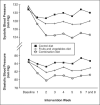Potassium, magnesium, and calcium: their role in both the cause and treatment of hypertension
- PMID: 18607145
- PMCID: PMC8109864
- DOI: 10.1111/j.1751-7176.2008.08575.x
Potassium, magnesium, and calcium: their role in both the cause and treatment of hypertension
Abstract
Despite advances in the prevention and treatment of hypertension over the past decade, hypertension remains an important public health challenge. Recent efforts to reduce the prevalence of hypertension have focused on nonpharmacologic means, specifically diet. An increased intake of minerals such as potassium, magnesium, and calcium by dietary means has been shown in some but not all studies to reduce blood pressure in patients with hypertension. This review will discuss the roles of potassium, magnesium, and calcium in the prevention and treatment of essential hypertension with specific emphasis on clinical trial evidence, mechanism of action, and recommendations for dietary intake of these minerals. A high intake of these minerals through increased consumption of fruits and vegetables may improve blood pressure levels and reduce coronary heart disease and stroke.
Figures



References
-
- Israili ZH, Hernandez‐Hernandez R, Valasco M. The future of antihypertensive treatment. Am J Ther. 2007;14:121–134. - PubMed
-
- Rosamund W, et al. >Heart disease and stroke—2008 update. A report from the American Heart Association Statistics Committee and Stroke Statistics Subcommittee . Circulation. 2008;17(4):e25. - PubMed
-
- Hajjar I, Kotchen JM, Kotchen TA. Hypertension: trends in prevalence, incidence, and control. Annu Rev Public Health. 2006;27:465–490. - PubMed
Publication types
MeSH terms
Substances
LinkOut - more resources
Full Text Sources
Medical
Miscellaneous

